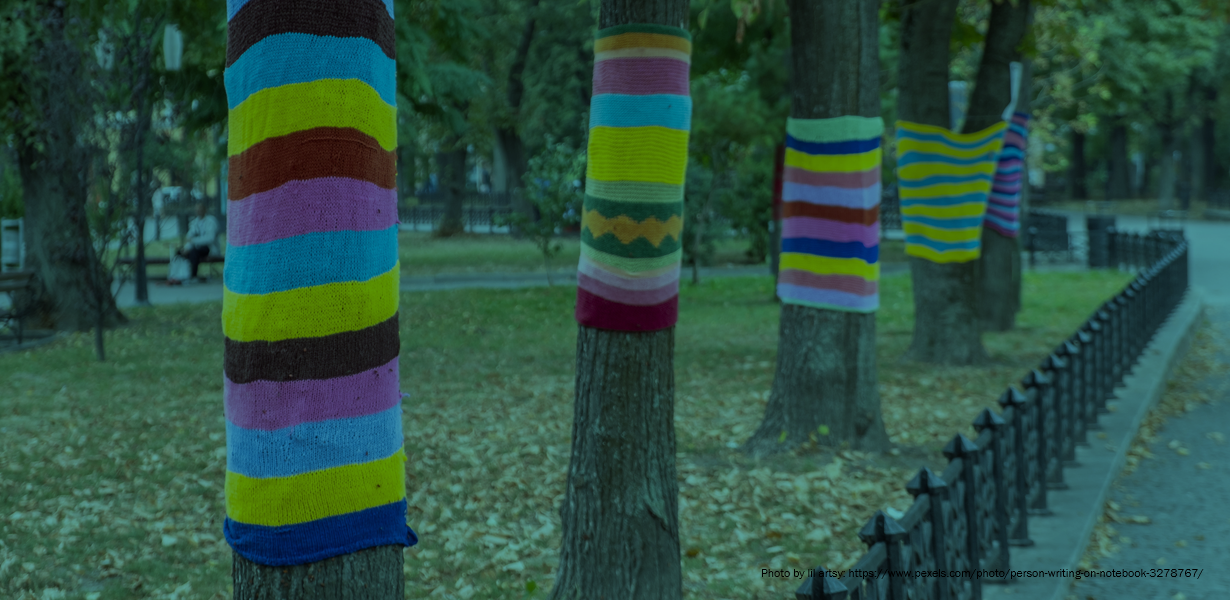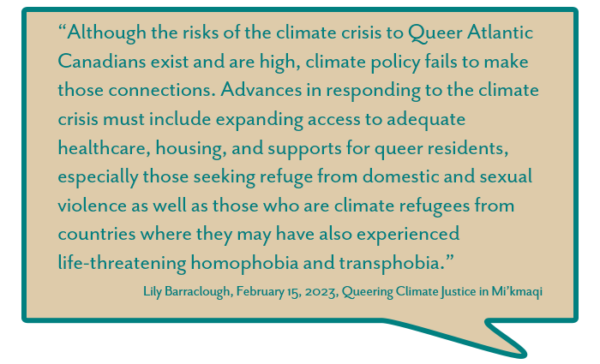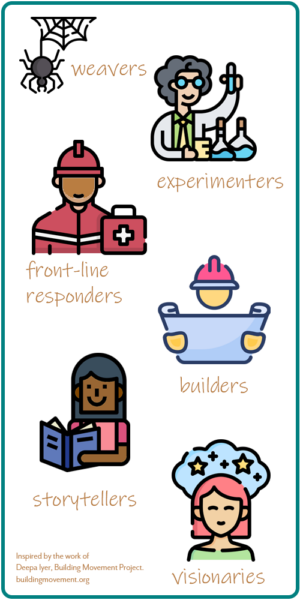Queering Climate Justice Now and Into the Future

by IC Environment Senior Fellow Lily Barraclough
When I first started this fellowship, as a Climate Research Fellow with Inspiring Communities, I had only grazed the surface of the 2SLGBTQIA+ dimensions of climate change. Through my year as a fellow, I had the opportunity to lay out the relevance of 2SLGBTQIA+ dimensions of climate change for Atlantic Canada (see blog here); facilitate a meaningful cross-discipline discussion on the lived and professional experiences of queer leaders working on climate and social justice issues in Atlantic Canada (see recording here); and most recently, I had the incredible opportunity to participate in a North America-wide roundtable representing Canada on the 2SLGBTQIA+ dimensions of climate change in Montreal led by the Commission for Environmental Cooperation (see details here). In this final reflection, I will outline some key learnings and questions that came up throughout this research exploration, some recommendations, and notes as to the future of this work.

I feel that this is the beginning, not the end, of this discussion in Atlantic Canada, and I hope that my work as a fellow has planted the seed for the impacts on queer individuals and communities to be accounted for in climate change mitigation and adaptation planning. To begin this long-term and meaningful discussion, open up some questions for you to consider in your work, whether it be directly on climate change, or in your community.
First, the challenging questions. These do not have simple answers, and they are not going to be quick to implement, but they are necessary to meet the challenge of the climate crisis and create safer communities for 2SLGBTQIA+ folks. These will be followed by some simple actions that can be easily implemented in daily practice.
- How can you transform the spaces in which you meaningfully connect and build relationships with others beyond a “table” or “circle” to be spaces that are accessible, built on strong relationships of trust and mutual understanding, and beyond binary thinking?

When considering the lived experiences of queer folks within the climate movement, as well as meaningful integration of 2SLGBTQIA+ dimensions of climate change into climate policies and actions, there needs to be transformative worldview changes. It is not enough to not be homophobic, transphobic, racist, or ableist, we need to actively challenge the heteronormative, white supremacist, and ableist structures of society. For instance, currently decision-making heavily relies on binary thinking: it is either climate mitigation or adaptation, either it is cost-effective or it is not, and so on. But to survive the multiple crises facing society, we have to move beyond that. Moving beyond the binary, in our worldviews and conceptualizing the issues we are facing, will make it safer for queer and trans folks.
There are no simple changes that can achieve this, but it might look like changing hiring practices within your organization, taking the time to build relationships with people already doing the work (avoid burning out individual leaders within communities), and showing up to public events to show support to the community (rallies, protests, Pride).
- How are the needs of 2SLGBTQIA+ communities covered by emergency response strategies in your organization or your government? How are you building those relationships and resilience in your personal life?

Emergency responses and disaster relief are critical in the face of climate change. Queer and trans folks are more likely to be housing insecure, they are more likely to lack access to appropriate healthcare, and they may have trouble accessing public services (like emergency shelters) for fear of discrimination; all of these conditions are exacerbated by disasters and emergencies. Emergency planning needs to account for providing gender-affirming and family-affirming services for queer and trans folks. You can also support this in your personal life. Build strong relationships with your neighbours and be prepared to support each other in the face of these crises. 2SLGBTQIA+ people are in all neighbourhoods and communities, and providing opportunities for relationship and resilience building among neighbours will only strengthen resilience in the face of climate change.
- Are nature and green spaces safe and accessible in your communities? How can you make them safer and more accessible?
Many queer and trans folks live in urban areas where nature, or even going outside, might not be readily accessible to them. Additionally, many spaces that are traditionally considered as “nature” are inaccessible to those without a car, and to those with mobility challenges. Nature and green space are crucial in supporting positive mental wellbeing, opportunities for recreation and exercise, and supporting resilience in the face of climate change.
- What will your role in the revolution be?

There are many ways that we/you/I can support transformative change that responds to the climate crisis, the needs of the 2SLGBTQIA+ community, and improves the lives of all. There are many resources that outline the potential roles you can play out there – but here is one to consider. The revolution needs us all, and we can all make meaningful contributions.
Next, here are some concrete actions that are simple to implement that can improve your organization’s/groups consideration of the 2SLGBTQIA+ dimensions of climate change:
- Normalize sharing pronouns – don’t force people to share their pronouns, but set an example by sharing your own.
- When working on climate change, consider how 2SLGBTQIA+ people might be impacted by your decisions/campaigns/actions.
- Read, listen to, and show up for 2SLGBTQIA+ people and communities. Do your own research, be willing to receive feedback, and normalize making mistakes and moving past them. It is okay to make a mistake, whether that be misgendering someone, or making assumptions about who they are or who they love, what matters is that you correct yourself, treat them with respect, and move on.
- Ensure that your event spaces are physically accessible and have gender neutral/all gender restrooms as much as possible.
- When planning outdoors events, provide as much information as possible on the length, difficulty, how to get there, and condition of the trails and use a variety of different trail types to make outdoors activity as accessible as possible.
- Slow down and ask the difficult questions, even when it is challenging.
As for me, my work on queering climate justice through this fellowship has inspired me to pursue a PhD studying these questions further. When I attended the roundtable on the 2SLGBTQIA+ dimensions of climate change in Montreal, for the first time, I had the opportunity to connect with other researchers and organizers working in this realm, and it was striking to me how much more work needs to be done, especially in Canada. I hope to continue working with Atlantic Canada communities to improve resilience in the face of the climate crisis and continue queering climate justice.
Image credits
- Canstock Images
- Still from recording, IC
- Spider icons created by Freepik – Flaticon
- Chemistry icons created by Eucalyp – Flaticon
- Paramedic icons created by kerismaker – Flaticon
- Constructor icons created by Vectors Tank – Flaticon
- Storytelling icons created by smalllikeart – Flaticon
- Dreams icons created by Freepik – Flaticon
Share this:
Comments are closed